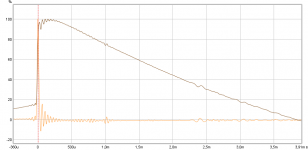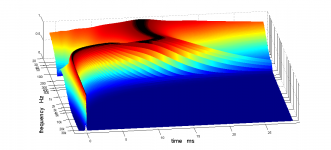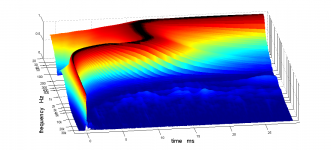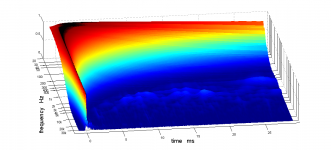Btw your responses look very nice.
In earlier posts I have tried to time offset linear phase filters. And the result is not so good. Especially high order ones. The group delay can be nasty of axis or with offset. (More than x degrees phase offset)
So to me it looks like higher order filters gives smaller listening sweetspot.
In earlier posts I have tried to time offset linear phase filters. And the result is not so good. Especially high order ones. The group delay can be nasty of axis or with offset. (More than x degrees phase offset)
So to me it looks like higher order filters gives smaller listening sweetspot.
Last edited:
So the moral is be careful to use the align function if your filters are not linear phase...
In free world we can do whatever we want
...Back to fig.3 Is it total impulse and stepfunction and not LP/HP impulses?
Yes its IR and SR for systems summing pass-band.
Attachments
Btw your responses look very nice.
In earlier posts I have tried to time offset linear phase filters. And the result is not so good. Especially high order ones. The group delay can be nasty of axis or with offset. (More than x degrees phase offset)
So to me it looks like higher order filters gives smaller listening sweetspot.
Thanks, there is also many times put to it and it sounds as great as it looks not to say that at calibration point sound is stunning, had never had a chance to get there without Rephase/REW and what it learned me about pass bands.
Guess what saves particular exercise setup have widest sweet spot is because ctc is so close as 1/8 wave-length and think most extreme offset error vertical is too small compared to wavelength at 180Hz is 1,9 meter that it matters, tonality inside room and also down the hall and into next room is noticed the same and polars for both woofer and mid-tweeter is fully omni and that will hold up to about 3500Hz where 68mm diameter starts narrowing beam, but its an exercise speaker and in long run even it gets more complex got to make it a 3-wayer with a narrow filler because it cost HD in 180-300Hz area let mid-tweeter 10F go so low.
Ha ha talking nasty group delay i show you my SNAKE 96dB/oct before linearization, first one is Rephase created IR used as textbook target response, second one is real acoustics and third one is real acoustics after linearization but at the time when config was 48dB/oct.
Attachments
Regarding phase: Of course all the requirements of Linkwitz must be taken account for. (Not just the 24 db/oct and -6dB at xover)
Then, to me, it looks like REW uses the top of the IR to find acoustic centers. That means phase is "disregarded" as first option. One have to "make minimum phase" before phase information seems right.
So it is difficult to retreve the rigth time information between drivers without measuring the two (or more ) drivers in one measurement.
Regarding the snake: Guess the group delay is only from the filter?
The woofer has also its own group delay because of HP nature. More group delay if ported.
I use the speakers with Xbox also so can't afford the delay of an "anti snake filter"
Then, to me, it looks like REW uses the top of the IR to find acoustic centers. That means phase is "disregarded" as first option. One have to "make minimum phase" before phase information seems right.
So it is difficult to retreve the rigth time information between drivers without measuring the two (or more ) drivers in one measurement.
Regarding the snake: Guess the group delay is only from the filter?
The woofer has also its own group delay because of HP nature. More group delay if ported.
I use the speakers with Xbox also so can't afford the delay of an "anti snake filter"
I posted an article on how to leverage AMD's affordable APUs to build a HTPC that's quite a bit cheaper than what was possible two years ago.
If anyone's interested in building a HTPC for Rephase, read this: http://www.diyaudio.com/forums/pc-based/308650-150-htpc-thats-beast.html#post5099504
If anyone's interested in building a HTPC for Rephase, read this: http://www.diyaudio.com/forums/pc-based/308650-150-htpc-thats-beast.html#post5099504
Last year, Pos the author of rePhase and JohnMP the author of REW, have implemented an interface in order to allow usage of amplitude correction filters generated inside REW in rePhase, and improve the possibilities to use rePhase as a tool to generate room corrections.
Since the 5.18 beta version of REW, JohnMP has implemented some new features which allow:
This manual is available here: https://www.dropbox.com/s/10xdhh83jokzbxv/REW_rePhase_tuto.pdf?dl=0
Thanks again to JohnMP and to Pos for making this interface so easy to use
Since the 5.18 beta version of REW, JohnMP has implemented some new features which allow:
- to simplify the averaging of measurements (time alignment and vector averaging)
- to generate a minimum phase and an excess phase versions of any measurement, which allow to greatly simplify the possibility to use rePhase in order to generate a minimum phase correction of any system.
This manual is available here: https://www.dropbox.com/s/10xdhh83jokzbxv/REW_rePhase_tuto.pdf?dl=0
Thanks again to JohnMP and to Pos for making this interface so easy to use
Hello SwissBear,
Very nice tutorial, thank you!
I for one will certainly rely on it in the near future
Hi Pos, Thanks for the kind words
Great tutorial for simple users and beginners... thanks !
Do you have a procedure for the appropriate way to make multiple measurements ?
Do you want me to make one ?
Hi Silverprout, Thanks. I have not made any explanation on the measurement procedure, as I thought it was quite straightforward. But if you find it useful, you are very welcome to make one.
So to me it looks like higher order filters gives smaller listening sweetspot.
Very interesting.
Why would that be?So to me it looks like higher order filters gives smaller listening sweetspot.
Hi,
Is it possible to import FIR filters created in Rephase to sigmastudio to use with ADAU1452?
Yes, i tested with 32 / 64 bits floats mono (.txt) format
Why would that be?
When correcting reflections or standing waves with sharp/'high Q' filtering. It is local interference that is corrected.
-> long filters,1 second, high Q, lot of dB correction, the filter is only good inside a few centimeters (Assuming here that first reflection from floor, walls and roof is corrected)
-> short filters,1 ms second, low Q, few dB correction, the filter is good inside a few meters. (Assuming here that the power responce is corrected)
A long FIR with low Qs are of course OK, but then a short filter can be used
Thanks Jmbee. Can you please describe how to do it if possible in a step by step way?Yes, i tested with 32 / 64 bits floats mono (.txt) format
Thanks Jmbee. Can you please describe how to do it if possible in a step by step way?
An externally hosted image should be here but it was not working when we last tested it.
When correcting reflections or standing waves with sharp/'high Q' filtering. It is local interference that is corrected.
-> long filters,1 second, high Q, lot of dB correction, the filter is only good inside a few centimeters (Assuming here that first reflection from floor, walls and roof is corrected)
-> short filters,1 ms second, low Q, few dB correction, the filter is good inside a few meters. (Assuming here that the power responce is corrected)
A long FIR with low Qs are of course OK, but then a short filter can be used
I have tried several different combinations of filters using my MiniDSP and I achieved smoothest power response using LR48dB filters and a very wide sweetspot (perhaps because of the waveguides).
Sorry mixed up. I was probably refering to the of axis responce of high order filters.
Remember a filter is only LR filters when the two drivers are time alligned and has constant phase difference a octave or two under and over the crossover frequency.
That is not so easy to achieve in real world.
So when the conditions are not met and we look at phase,groupdelay and possibly artifacts, an high order filter behaves worse than an loworder filter of axis.
That said, it may not be so noticable in an normal acousically active room where masking of such distortion is normal as the room itself makes a lot of high Q filters.
Remember a filter is only LR filters when the two drivers are time alligned and has constant phase difference a octave or two under and over the crossover frequency.
That is not so easy to achieve in real world.
So when the conditions are not met and we look at phase,groupdelay and possibly artifacts, an high order filter behaves worse than an loworder filter of axis.
That said, it may not be so noticable in an normal acousically active room where masking of such distortion is normal as the room itself makes a lot of high Q filters.
- Home
- Design & Build
- Software Tools
- rePhase, a loudspeaker phase linearization, EQ and FIR filtering tool



